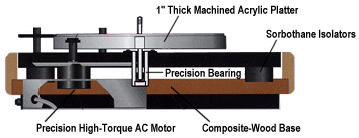You won’t go wrong with the VPI 19 Jr! Any part is still replaceable including belt, motor etc, etc.
VPI HW-19 JR (1993)


The beginning of the journey into High-End analog music reproduction starts with the HW-19 Jr. The Jr. is VPI’s most cost effective turntable. It combines the drive system of the MK. III & MK. IV, with a cost effective platter and subchassis, to give real value for the dollar.
The HW-19 Jr. features a six pound, one inch thick clear acrylic platter with a reflex record clamping system so effective that when the clamp is released, the record stays locked to the platter.
One of the hallmarks of the VPI playback system is proper mating of the record and the platter. Terminating the resonances excited by the stylus/vinyl interface is critical for lifelike reproduction of the low level nuances normally found in live music. In the HW-19 series of turntables, the resonances are terminated without vacuum, pumps, peripheral clamps, etc. Simple yet precise solutions are always the best.
All turntables must be isolated from the outside world. The Jr. uses sorbothane as the isolation material. The sub-chassis is set upon four sorbothane pucks that keep a large percentage of motor noise and acoustic feedback from reaching the platter and cartridge.
All the wood-finished bases are made from solid hardwoods. Veneer over particle board is never used. We use real oak naturally finished, real oak lacquered in semi-gloss black with the grain showing, and real walnut in a natural finish. As a premium option, a piano black high gloss finish is offered.
The Jr. uses the same drive motor as the MK. III, and MK. IV, a low noise precision AC Synchronous type with quiet bearings, and high torque. The drive belt is a unique pyrothane material that lasts many years with excellent serviceability. It has a round cross section for excellent speed stability and low noise. The motor pulley is machined from black delrin with a concentricity of +/- .0002".
The Jr. is fully set up at the factory and can be up and running in less than 10 minutes. If your Jr. is ordered with a factory mounted tonearm, all you need to do is install the cartridge.
-
1” thick clear or black acrylic platter
-
Sorbothane suspension
-
600 RPM AC synchronous motor
-
1 piece 1” thick MDF plinth
-
Precision “O” ring drive
-
Hinged-acrylic dust cover



